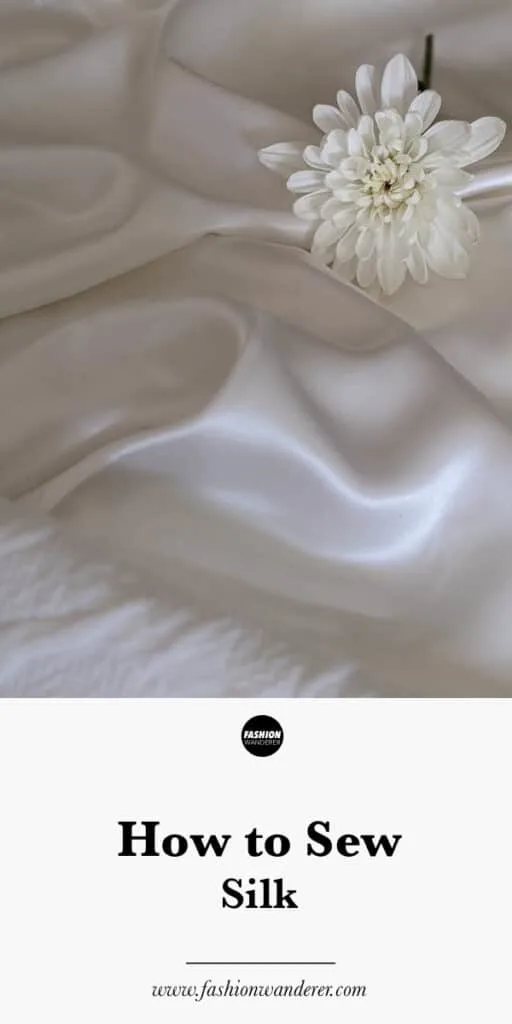Are you having hard time to sew silk garments? Silk is a sensuous and luxurious fabric that is created from silkworm cocoons.
Whether you are sewing structured square neckline camisole or lace trimmed camisole, silk tops are an essential garment to add to every women’s DIY wardrobe.
How do you sew silk? Select an extra-fine sewing needle of 60/8 or 70/10 to create quality stitches without damaging the fabric. Place a piece of tissue paper under the silk fabric or use stabilizer when sewing.
Adjust the sewing machine to 1.5 or 2mm stitch length. Finish the raw edges with French seam or overlock stitch with a serger.
Working with a slippery fabric such as silk is very challenging, especially for beginner with a regular sewing machine. Silk is also the strongest natural fiber, however it makes neat edges difficult to achieve.
This article covers simple techniques that make sewing silk easier and more achievable. This post answers frequently asked questions about sewing silk so that you can confidently more forward in your next silk garment.
Is silk easy to sew?
Silk has a smooth and slippery texture, therefore it can get challenging to sew. With specialized techniques, silk sewing can get easier.
Being a slippery fabric, it becomes tough from the cutting stage to get neat edges. In addition, its slippery nature makes silk fabric feeding difficult on the sewing machine.
It is recommended to select the sewing machine foot like a walking foot for sewing silk. You also need the right needle and thread when handling silk to avoid puckering or pulling of the fabric.
A walking foot can assist in pulling the fabric through with appropriate tension when sewing with a machine. Pull the needle and bobbin thread gently, and alternate when beginning to stitch silk for the fabric movement in the sewing machine.
In addition, a wash-away, tear-away or spray fabric stabilizer can be used to strengthen the flimsy fabric during sewing. You can alternatively use tissue paper which can be torn off later.
These method help to feed the sewing machine more efficiently without sliding around every time.
Thread tension for silk fabric
When handling silk for sewing, a smaller stitch length is suitable and appropriate. Lightweight fabrics such as silk are sewn best with a stitch length of 1.5mm-2mm, this gives a good thread tension for silk fabric.
When beginning to sew, ensure the tension of the top needle thread and bottom bobbin thread are appropriate and in alignment. Use a scrap of fabric to test for the right tension and verify that the stitches do not wrinkle, pull or pucker the fabric.
Make adjustments until you achieve a clean stitch on both sides of the fabric. Thread tension can be a frequent adjustment as per the design or style implemented with the fabric.
Avoid backstitching and secure threads manually as silk can be swallowed into the opening of the needle plate.
The best thread for sewing silk fabric
A good quality polyester or cotton thread is great for sewing silk fabric. Choosing the right thread that matched your silk fabric is essential to get a neat and clean stitch.
100% polyester thread or cotton wrapped polyester thread are ideal. A silk thread can fray and is not quite strong enough for regular wear and tear.
A quality sewing thread ought to be weaker as compared to the fabric stitching. This is because the seam, stitching or the thread breaks in an unlikely case rather than tearing away the fabric itself.
This is why 100% polyester or cotton thread are ideal to sew silk fabric.
Selecting the proper thread content not only secures seams together so that they last long, but also help to avoid breaking thread on the sewing machine and even after multiple wears as well.
Needle for silk fabric
A right needle for silk fabric is a small and sharp needle. Use 70/10 or 60/8 for lightweight fabrics like silk, chiffon, or georgette while for medium-weight silk fabrics 80/12 will be better suited.
In general, select a smaller needle when sewing delicate silk. A sharp and fine smaller sewing needle will not leave big holes in the fabric.
Silk is a fabric that can show the pricks easily, a smaller-sized needle is just right for sewing through the delicate material.
If you are working on multiple silk garment projects, evaluate each time when to replace sewing needle and have some extra needles handy as silk fibers tend to dull the sewing needle quickly. A dull needle will begin creating holes that are impossible to get rid of.
How to sew silk fabric
As a beginner, sewing silk may look intimidating and hard to achieve a professional look because it is known as a slippery fabric.
Other than preparing the correct tools, correctly thread the sewing machine to nail the clean stitches. Furthermore, there are a couple of things to note for easy sewing.
Follow these steps to sew silk fabric:
- Hand baste the silk fabric pieces together in alignment using loose and long stitches to hold the silk fabric in place temporarily. This makes sewing silk fabric easy as silk tends to slip off and is hard to hold in place. Hand basting will help to make a dotted line to sew on it later with a sewing machine and simply remove the basting thread.
- When sewing silk, place tissue paper under the silk fabric to avoid slipping away. The needle sews both layers and once done, you can tear the tissue easily.
- If you do not want to use tissue paper, spray on fabric stabilizer. This spray stiffens the fabric to avoid slipping to better manage the fabric when cutting or sewing.
- Test the machine for the correct tension and stitch on a scrap fabric piece. Adjust accordingly to make a neat stitch thereby gauging the thread. Consider purchasing a little extra fabric to test the thread and needles before beginning the main project.
- Set the stitch length for 8-12 stitches per inch, this may differ from one project to another.
- Pull the bobbin and needle thread back away from you when setting the fabric in place on the machine. This makes sure there is no accidental wrapping in the walking or machine foot. If not, there could be pulls or holes in the silk fabric while sewing.
- Bring down the needle manually into the silk fabric using the hand wheel rotation. This avoids puckering or foot catch when beginning to sew the silk fabric.
- Hold the silk fabric straight and flatten the fabric gently to feed straight in the sewing machine. Do not pull as it can result in puckers throughout the stitching.
- Sew straight stitches without backstitch, and manually make a knot to secure the fabric. Ensure the fabric does not bunch or get swallowed by the machine.
- Sew slowly for consistent and even stitches.
- Keep ensuring the fabric is fed appropriately and timed by looking for flat sewing on the seams with no snags.
- Check for ripping seams as there could be holes within the fabric. When ripping is needed, rub the pricked holes on the fabric downside, spray the fabric with water very lightly, and then iron on medium or low setting to close any holes.
How to finish silk edges?
Finishing the silk edges is very essential as silk frays easily. Use a French seam or serger to finish silk edges.
Leaving edges undone or doing this incorrectly can compromise the sewing quality and overall results of the finished project.
A serger can be used to get a clean and neat finish. This sews the fabric edge and also seals it with overlock stitch.
You can also use a zigzag stitch, hand-overcast, and seam binding for finishing the silk edge.
If you are not using a serger machine, trim down the silk fraying edges and then apply the special types of stitches. Trim the frays and loose threads for even edges, and then finish with the desired method.

Sewing Silk: Final Thoughts
It is easy to sew silk if you know the technique, tips, and tricks. Silk fabric is a smooth and strong natural fiber compared to linen or cotton fabrication.
Always pre-wash and treat the silk fabric to get ready to cut and sew. When transferring the sewing pattern onto the fabric, use extra fine silk pins to pin through the fabric and cut out the pieces.
If you are new to sewing silk, use hand basting method to join the pieces together before sewing with a machine. The long hand stitches will help guide the stitch direction and make sewing even easier to execute.
Add a piece of tissue paper underneath the silk or spray stabilizer to stiffen when cutting or sewing. Always test on a scrap of silk to verify stitch width, length, and tension for the specific fabric you are working with.
Ideal stitches per inch need to be 8-12 stitches, which equals 1.5 to 2mm on the sewing machine. Depending on the project and fineness of the silk, shorter or longer stitch length may be required.
Adjust the bobbin and manually bring the needle down slowly so it won’t make the fabric pucker or catch on the sewing foot. Start sewing silk fabric by holding the fabric straight without pulling.
Avoid using backstitch as it may bunch up or jam the fabric in the sewing machine. So start with straight stitch and leave extra thread to manually knot and secure the stitches.
Sew slow and steady, and apply indirect heat when pressing the seam by using a pressing cloth on top.
Silk fabric has a tendency to fray similarly to linen fabric. So, finish all edges with serger or French seam as indicated as the sewing pattern.
Tool preparation and the proper sewing machine setting is all you need to sew silk efficiently and professionally. Use these sewing tips and techniques to help you sew silk the right way.
